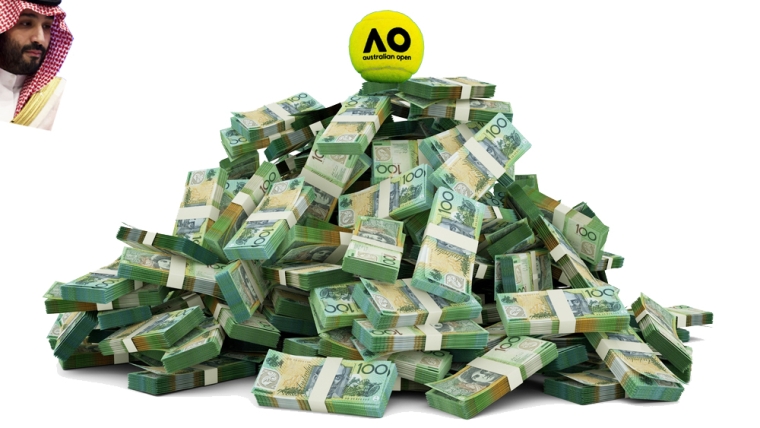
What do Melbourne, Christchurch, and Hastings have in common?
They’ve all hosted the Australian Open tennis tournament. Although it was a while ago in the case of Christchurch (1906) and Hastings (1912), and back then it was known as the Australasian Championships.
The tournament’s come a long way since then. Known as the Australian Open since 1969 when professional players could compete for the first time, it’s now a truly international affair.
And a very big business.
The major sources of revenue for Tennis Australia, which runs the tournament, are ticket sales, retail activities within Melbourne Park, broadcast rights, and sponsorship deals.
Last year’s event set a new attendance record with about 840,000 fans through the gates over the tournament fortnight. This was well above the 2023 attendance at Wimbledon (532,000) and the French Open (630,000), but behind the US Open (950,000).
Tennis Australia is hoping for more than 900,000 spectators this year. That’s a big earner. While a ground pass is relatively cheap, expect to pay hundreds of dollars for good seats in the main arenas, with prices rising as the tournament progresses.
As at the time of writing, a few tickets are still available for the men’s final ranging in price from $1,600 in the ‘nosebleed’ section to $5,000 and above closer to the action.
Watering and feeding nearly a million people generates significant revenue for both Tennis Australia and the array of bars, restaurants, and food stands within Melbourne Park. Some of the country’s top purveyors of food and wine are represented.
The Australian Open is broadcast around the world by a range of broadcasters including Supersport, ESPN, Eurosport, and NZ’s Sky. The Australian broadcast rights are held by Nine Entertainment. It recently paid $425 million for a five-year extension of those rights through to 2029.
Tournament sponsorship is also highly lucrative. The Kia car company has sponsored the Australian Open since 2002 and is now described as the tournament’s ‘Major Partner’. According to the Australian Financial Review, the current five-year deal is worth $107 million and is ‘the biggest sports sponsorship deal in Australian history’.
The tournament’s website identifies 32 AO Partners. That includes the usual suspects like an Official Wine and an Official Airline. Perhaps more surprising are the Official Cyber Security Partner, the Official Health Supplement Partner, and the Official Insurance Partner.
The presence of premium brand sponsors like Louis Vuitton, Rolex, Piper-Heidsieck, and Polo Ralph Lauren indicates the perceived market position of tennis and its followers. It’s a very different demographic to rugby league.
Nothing highlights the link between Tennis Australia and business better than a recent initiative called ‘AO Startups’. According to the Australian Open website, this is ‘the latest step in the Tennis Australia venture capital strategy which helps early-stage companies pilot their cutting-edge technology at the AO’.
There’d be no ticket sales, broadcast revenue, or sponsorship agreements, let alone a ‘venture capital strategy’, without the stars of the Australian Open – the players. But they’re well remunerated for their work. The total prize pool this year is A$86.5 million, up 13% on 2023.
Every player in the first round of the men’s and women’s singles (128 in each) takes home A$120,000. The men’s and women’s champions each receive A$3,150,000.
Those numbers sound impressive but the worry for the Australian Open, and the ATP tour, is that a tennis version of ‘LIV Golf’ might emerge to lure away the top players. LIV Golf is the professional golf tour funded by the Saudi Arabian sovereign wealth fund. It’s been able to challenge the traditional PGA tour thanks to the astronomical sums offered to the world’s top golfers. For example, Australia’s Cameron Smith received A$140 million just to join the LIV tour.
There are reports that the four grand slam tennis tournaments are working on a proposal to defend their turf against a LIV golf-type attack. This would involve the establishment of a ‘premier tour’ for tennis incorporating the four slams and several other top ATP tournaments. Even then, they would likely need financial input from the likes of a Saudi Arabia.
There’s a lot at stake here for Melbourne, not just Tennis Australia. In defending tens of millions of dollars in Covid-19-related support provided to Tennis Australia, the Victorian Minister for Tourism, Sport and Major Events, Steve Dimopoulos, claimed a recent 10-year extension to Melbourne’s AO hosting rights was worth $4 billion to Victoria.
The tournament certainly provides valuable international exposure. In 2023, 203 foreign journalists attended the Australian Open. Tennis Australia’s social media posts ‘generated over 780 million impressions, 29 million interactions and 470 million video views’.
The fact that Victoria has a Minister for Tourism, Sport and Major Events highlights the value the state attaches to major events generally, and sports spectaculars in particular. With a sporting calendar that includes the Australian Open, the Melbourne Grand Prix, and the Melbourne Cup, and with sports facilities like Melbourne Park and the MCG, the city can rightfully claim to be one of the world’s great sporting cities.
It’s a sign of the importance of the Australian Open that Victoria has launched a new tourism campaign entitled ‘Every Bit Different’ to coincide with the tournament.
Of course, having come out of the Covid-19 pandemic with the unfortunate moniker of ‘the world’s most locked-down city’, Melbourne can do with some positive promotion.
Interestingly, there are now reports that Victoria is currently experiencing a ‘double Covid-19 wave’. Let’s hope this year’s Australian Open doesn’t turn out to be a super spreader event.
*Ross Stitt is a freelance writer with a PhD in political science. He is a New Zealander based in Sydney. His articles are part of our 'Understanding Australia' series.
3 Comments
Melbourne was a magnificent city. Still is in places & at times. But the city & state leadership have done their level best to destroy what has taken 200 years of hard graft to get where it is today. Dirty Dan [ex Victorian premier] has left the building, thank goodness, but we are seeing how the social democrats [socialists] are running great cities into the ground right across the western world [San Francisco, Portland, New York] Melbourne's glory days are fast coming to an end. Sadly.
Yeah the right wing car dominated cities are so much nicer.
I've enjoyed watching Arthur Cazaux in his last two matches. If that's his usual level of play then the next superstar has arrived.

We welcome your comments below. If you are not already registered, please register to comment
Remember we welcome robust, respectful and insightful debate. We don't welcome abusive or defamatory comments and will de-register those repeatedly making such comments. Our current comment policy is here.